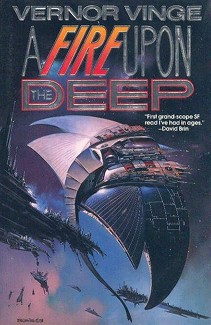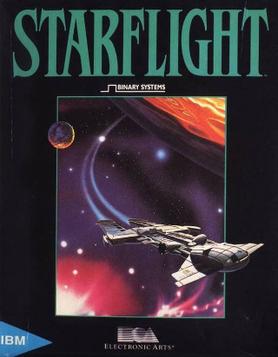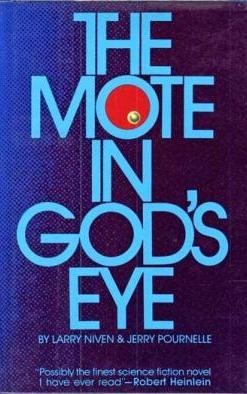Related Research Articles

A Fire Upon the Deep is a 1992 science fiction novel by American writer Vernor Vinge. It is a space opera involving superhuman intelligences, aliens, variable physics, space battles, love, betrayal, genocide, and a communication medium resembling Usenet. A Fire Upon the Deep won the Hugo Award in 1993, sharing it with Doomsday Book by Connie Willis.

The Illustrated Man is a 1951 collection of 18 science fiction short stories by American writer Ray Bradbury. A recurring theme throughout the stories is the conflict of the cold mechanics of technology and the psychology of people. It was nominated for the International Fantasy Award in 1952.
A sleeper ship is a hypothetical type of crewed spacecraft, or starship in which most or all of the crew spend the journey in some form of hibernation or suspended animation. The only known technology that allows long-term suspended animation of humans is the freezing of early-stage human embryos through embryo cryopreservation, which is behind the concept of embryo space colonization.

Who Goes There? is a 1938 science fiction horror novella by American author John W. Campbell, written under the pen name Don A. Stuart. Its story follows a group of people trapped in a scientific outpost in Antarctica infested by shapeshifting monsters able to absorb and perfectly imitate any living being, including humans. Who Goes There? was first published in the August 1938 issue of Astounding Science Fiction magazine and was also printed as The Thing from Another World, as well as included in the collection by the same title. Its extended, novel version, found in an early manuscript titled Frozen Hell, was finally published in 2019.

Starflight is a space exploration, combat, and trading role-playing video game created by Binary Systems and published by Electronic Arts in 1986. Originally developed for IBM PC compatibles, it was later ported to the Amiga, Atari ST, Mac, and Commodore 64. A fully revamped version of the game was released for the Genesis in 1991.

The Mote in God's Eye is a science fiction novel by American writers Larry Niven and Jerry Pournelle, first published in 1974. The story is set in the distant future of Pournelle's CoDominium universe, and charts the first contact between humanity and an alien species. The title of the novel is a reference to the Biblical "The Mote and the Beam" parable and is the nickname of a star. The Mote in God's Eye was nominated for the Hugo, Nebula and Locus Awards in 1975.
Renegade Legion is a series of science fiction games that were designed by Sam Lewis, produced by FASA, and published from 1989 to 1993. The line was then licensed to Nightshift games, a spin-off of the garage company Crunchy Frog Enterprises by Paul Arden Lidberg, which published one scenario book, a gaming aid, and three issues of a fanzine-quality periodical before reverting the license.

The Smoke Ring is a 1987 science fiction novel by Larry Niven. Like much of Niven's work, the story is heavily influenced by the setting: a gas torus, a ring of air around a neutron star. It is a sequel to The Integral Trees.

Space Cases is a Canadian science fiction television series that aired on Nickelodeon for two seasons. Created by Peter David and Bill Mumy, it premiered on March 2, 1996, and ended on January 27, 1997, with reruns until 1998. Space Cases aired for a time on Nickelodeon's Saturday night block of shows known as SNICK, and on Nickelodeon UK, with reruns on Family and TVOntario in Canada.

Inconstant Moon is a science fiction short story collection by American author Larry Niven that was published in 1973. "Inconstant Moon" is also a 1971 short story that is included in the collection. The title refers to "O, swear not by the moon, th' inconstant moon", a quote from the balcony scene in William Shakespeare's Romeo and Juliet. The collection was assembled from the US collections The Shape of Space and All the Myriad Ways.

I Married a Monster from Outer Space is a 1958 American horror science fiction film from Paramount Pictures, produced and directed by Gene Fowler Jr., that stars Tom Tryon and Gloria Talbott. Paramount released the film as a double feature with The Blob.
The Commonwealth Saga is a series of science fiction novels by British science fiction writer Peter F. Hamilton. This saga consists of the novels Pandora's Star (2004) and Judas Unchained (2005). Hamilton has also written several books set in the same literary universe. Misspent Youth (2002) takes place 340 years before the events of Pandora's Star. The Void Trilogy, consisting of The Dreaming Void (2008), The Temporal Void (2009), and The Evolutionary Void (2010), takes place 1,200 years after the events of Judas Unchained; several of the main characters from Judas Unchained and Pandora's Star also appear in the Void trilogy.

The Man-Kzin Wars is the name of a series of military science fiction anthologies as well as the name of the first book in the series. The short stories detail the eponymous conflicts between mankind and the Kzinti, set in Larry Niven's Known Space universe. However, Niven himself has written only a small number of the stories; most were written by other science fiction writers, as Niven opened this part of the Known Space to collaboration in the form of a shared universe. The cover art for the books in the series is created by Stephen Hickman.

Alternate Realities is a 2000 omnibus collection of three short science fiction novels by American writer author C. J. Cherryh: Wave Without a Shore (1981), Port Eternity (1982), and Voyager in Night (1984). All three novels are set in Cherryh's Alliance-Union universe and share a common theme of people encountering and coping with a reality different from their own.

The Collected Stories of Vernor Vinge is a collection of science fiction short stories by American writer Vernor Vinge. The stories were first published from 1966 to 2001, and the book contains all of Vinge's published short stories from that period except "True Names" and "Grimm's Story".

"First Contact" is a 1945 science fiction novelette by American writer Murray Leinster, credited as one of the first instances of a universal translator in science fiction. It won a retro Hugo Award for Best Novelette in 1996.
"The Liberation of Earth" is a science fiction short story by American author William Tenn, written in 1950, first published in 1953, and reprinted several times in various anthologies, including 1955 collection Of all Possible Worlds and 1967 anthology The Starlit Corridor. The story, which Tenn described as having been inspired by the Korean War, describes Earth becoming a battleground between two powerful alien races who repeatedly "liberate" it from each other.

Alien is a 1979 science fiction horror film directed by Ridley Scott and written by Dan O'Bannon, based on a story by O'Bannon and Ronald Shusett. It follows a spaceship crew who investigate a derelict spaceship and are hunted by a deadly extraterrestrial creature. The film stars Tom Skerritt, Sigourney Weaver, Veronica Cartwright, Harry Dean Stanton, John Hurt, Ian Holm, and Yaphet Kotto. It was produced by Gordon Carroll, David Giler, and Walter Hill through their company Brandywine Productions and was distributed by 20th Century-Fox. Giler and Hill revised and made additions to the script; Shusett was the executive producer. The alien creatures and environments were designed by the Swiss artist H. R. Giger, while the concept artists Ron Cobb and Chris Foss designed the other sets.

The Long Result is a 1965 science fiction novel by British writer John Brunner.
References
- ↑ "Index to Science Fiction Anthologies and Collections". Archived from the original on 2012-11-02. Retrieved 2009-09-12.